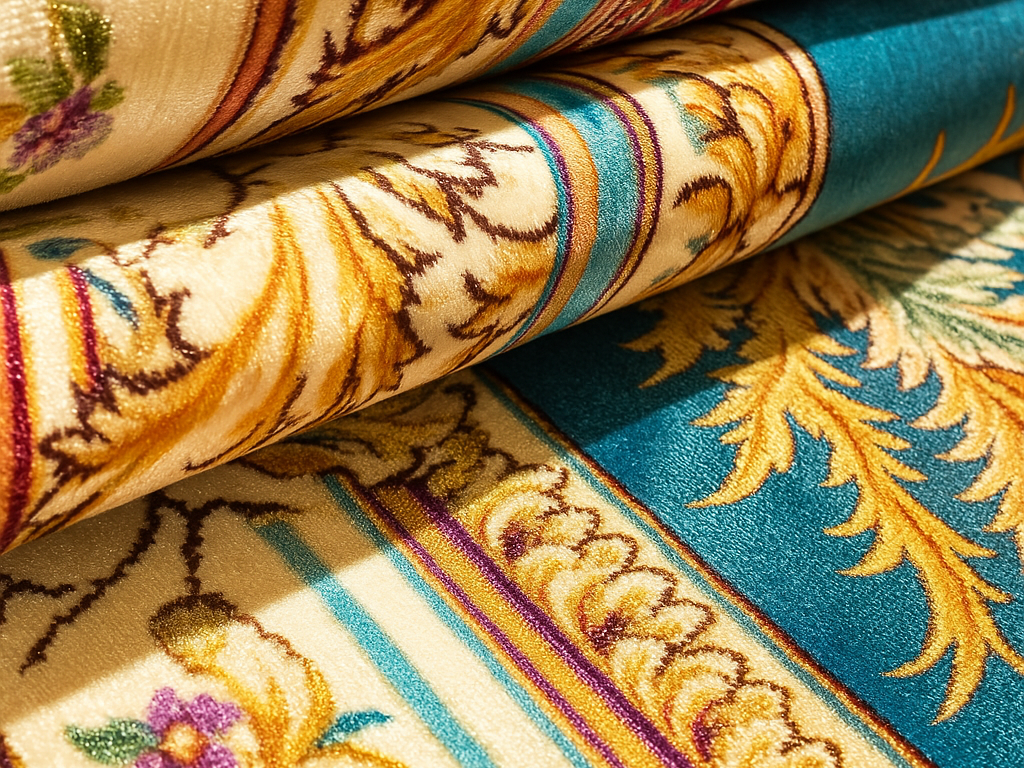多忙なプロフェッショナル・スペースの床材を計画する際、一般的にひとつの疑問が浮かび上がる: 業務用カーペットとは? 居心地のよい家庭用カーペットとは異なり、業務用カーペットはオフィス、ホテル、空港、医療施設など、人の往来が多いスペース用に設計されています。パイルが少なく、ループ状の構造で、溶液染めのナイロンやポリプロピレンのような頑丈な繊維を使用しているため、耐久性に優れ、汚れにくく、メンテナンスが簡単です。
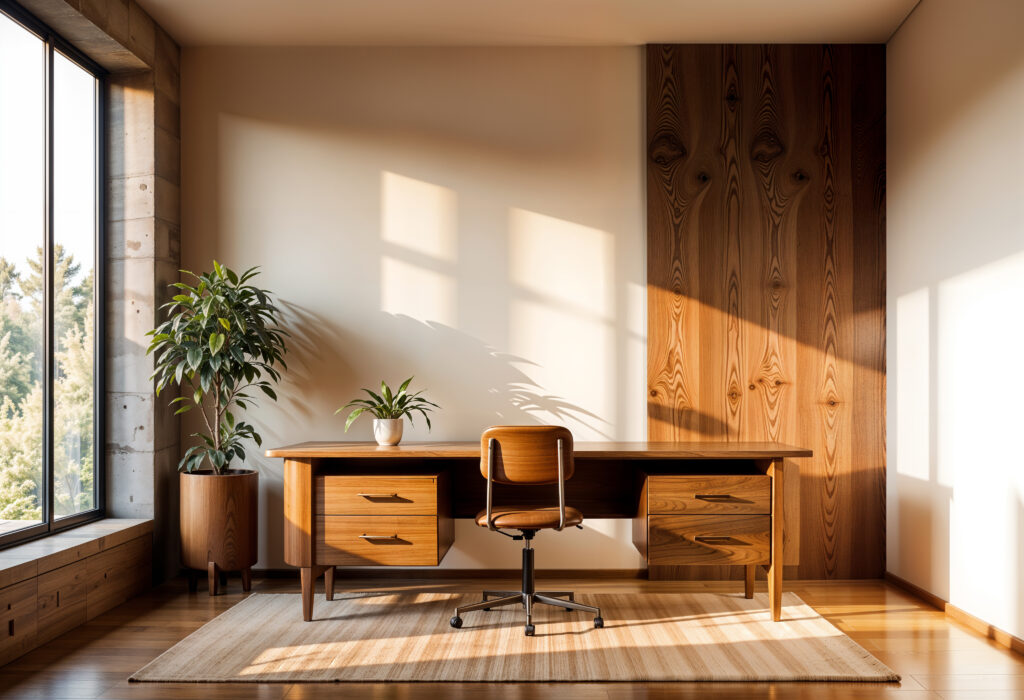
しかし、タフさだけでなく、デザインも重要だ。モジュール式から カーペット タイル 迅速な交換や独創的なレイアウトを可能にし、シームレスなレイアウトを可能にする。 ブロードルーム・ロール 洗練された統一感のある仕上がりの業務用カーペットは、機能性と美観をシームレスに融合します。賑やかなオフィスでも、活気あふれる店舗でも、業務用カーペットのユニークな構造と利点を理解することで、よりスマートで長持ちする床材を選ぶことができます。
1.業務用カーペットとは?
業務用カーペットは機能性を重視して設計されており、特に人の出入りが多く、汚れに強く、メンテナンスが簡単なように設計されています。柔らかさと心地よさを優先する住宅用カーペットとは異なり、業務用カーペットは耐久性、低パイル構造、ループ状の繊維による堅牢性を重視しています。カーペットは床材の主力製品で、次のような場所で使用されています。 事業所, ホテル学校、医療施設、小売店など、耐久性と実用性が重視される場所だ。
その特徴はこうだ:
- ローパイル、ループ構造 忙しい場所でも長く使えるように。
- 溶液染め ナイロン またはポリプロピレン繊維 汚れや色あせに強い。
- 簡単な交換システムタイルカーペットのように、費用対効果の高いメンテナンスができる。
2. 業務用カーペットの種類とは?
業務用カーペットは、人の往来が多く、使用頻度の高い環境、つまりスタイルと実質が一致しなければならない場所のために設計されています。その主な特徴は、耐久性、メンテナンスのしやすさ、実用性です。ここでは、その特徴をご紹介します:
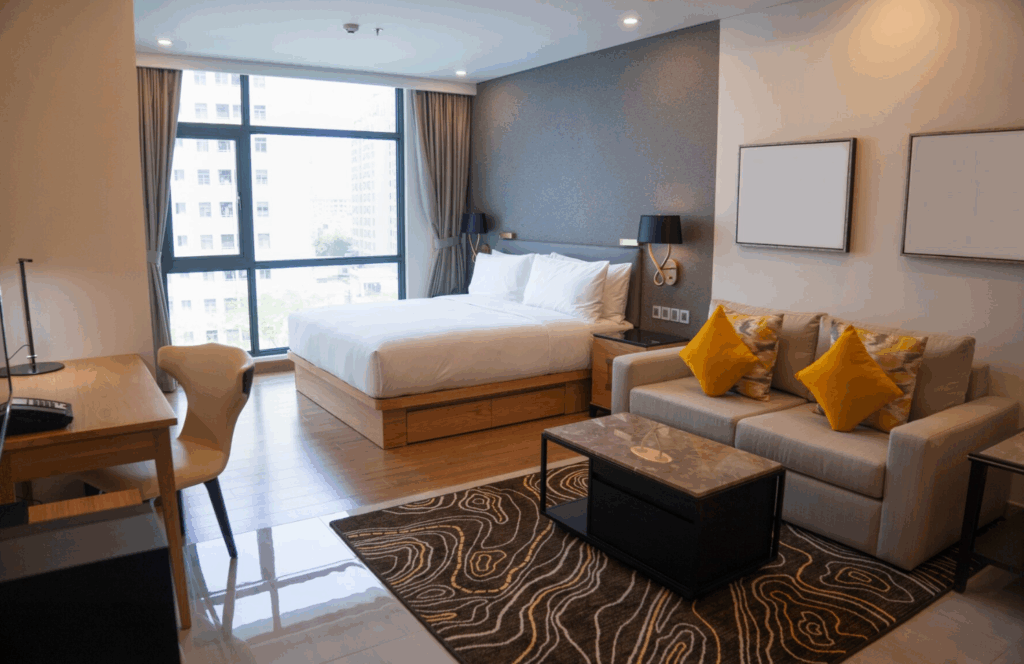
構造と繊維構成
- ローパイル、ループ構造:主にループパイル(ベルベルやレベルループのような)で、ループ状の繊維をそのまま残し、マットになりにくい高密度で弾力性のある表面を作り出します。
- 堅牢 ファイバー・オプション:
- ナイロン:業務用カーペットの主力商品で、弾力性に富み、糸の記憶性と耐摩耗性に優れる。
- ポリプロピレン(オレフィン):汚れや水分に強く、コストパフォーマンスに優れるが、耐摩耗性に劣るため、人の出入りが少なかったり、こぼれやすい場所に最適。
- ポリエステル:鮮やかな発色と疎水性、より手頃な価格だが、酷使すると平らになることがある。
- ウールと合成繊維の混紡:高級感と性能を融合させ、自然な難燃性と豊かな色彩を提供する。
カーペットのバッキングとサポート
強力なバッキングが不可欠である。一般的なバッキングには、ラテックス、ポリウレタン、熱可塑性層などがある:
- ファイバータフトをしっかりとロック耐久性を高め、ほつれを防ぐ。
- 寸法安定性を高める 設置の容易さ
- 耐湿性とクッション性タイプによる
フォーマットとインストール
- ブロードルーム・ロール:従来の壁から壁へのロールは、美観がきれいで継ぎ目が少なく、通常、広い面積でより経済的だが、廃棄物が多くなる可能性がある。
- カーペット タイル モジュラー・プランク:耐久性に優れた正方形(18~36インチ)で、設置、交換、再配置が簡単。モジュラーセットアップに最適で、破損時のダウンタイムを短縮。
製造方法
- タフティング:一般的な方法(~95%のカーペット)。ヤーンループをバッキングに通して縫製する。テクスチャーや仕上がりに柔軟性がある。
- 機織り:糸とバッキングを同時に一体化し、複雑なパターンを表現(例:アックスミンスター)。コストは高いが、耐久性と美観に優れている。
グレーディングと仕様
業務用カーペットは、通行量、繊維密度、タフト結合、バッキングシステムなどの要素に基づいて等級付けされます。等級(中程度、重い、厳しい)は、カーペットが使用目的に合っていることを保証します。
3.長所と短所は何か 業務用カーペット?
業務用カーペットは人通りの多い環境には大きなメリットがありますが、欠点もあります。それぞれについて詳しく見ていきましょう。
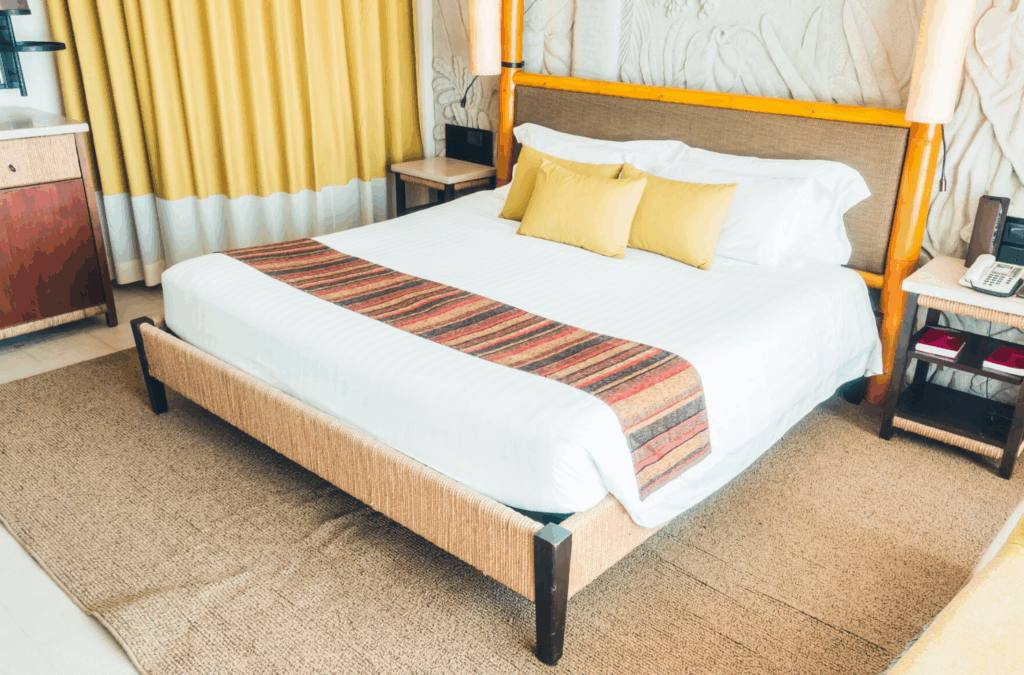
長所 業務用カーペット
- 耐久性と寿命: 激しい往来に耐えるように設計された業務用カーペットは、マットや摩耗に強い。低パイルループと緻密な構造により、住宅用カーペットよりもずっと長く新鮮な状態を保つことができます。
- ノイズリダクションとアコースティックコンフォート: カーペットは音を吸収し、反響音や周囲の騒音を大幅にカットします。 ホスピタリティ・スペース.
- 足元の快適さ: 硬いフローリングに比べ、カーペットは柔らかいクッション性があり、長時間立っているスタッフの疲労を軽減する。
- 美的柔軟性: 豊富な色、柄、タイル形式を取り揃えた業務用カーペットは、デザインの目的に応じて、大胆なブランディングやシームレスなエレガンスをサポートします。
- モジュール式で費用対効果の高い交換: タイルカーペットは、床全体を書き換えることなく、傷んだ箇所を狙い撃ちして交換することができる。このモジュール化により、時間とコストを大幅に節約できます。
- 健康と室内空気の質の向上: カーペットは定期的に掃除することで、ホコリやアレルゲン、汚染物質を閉じ込め、掃除機やディープクリーニングで取り除くことで、室内の空気の質を高めます。
- 長期的な貯蓄: 初期費用はそれなりにかかるかもしれないが、寿命が長く、修理の必要性が少なく、全交換の頻度が少ないため、ライフサイクル全体の費用は低くなる。
の短所 業務用カーペット
- クリーニングとメンテナンスの必要条件: エリアカーペットの性能を維持するには、定期的な掃除機がけと専門家によるディープクリーニングが必要です。適切なクリーニングを怠ると、土が蓄積して繊維が傷んでしまいます。
- 汚れと食べこぼし: しかし、コーヒー、インク、油、ワインなどをこぼした場合は、迅速かつ適切な処置が必要です。
- 交通量の多いゾーンでの目に見える摩耗: 特にメンテナンスを怠ると、耐久性のあるカーペットでも、時間が経つにつれて路面の摩耗や変色が目立つようになります。
- アレルギーへの配慮: 室内の空気の質は改善されたとはいえ、カーペットは手入れを怠るとダニなどのアレルゲンを閉じ込める可能性がある。過敏症の方は、より頻繁な掃除が必要になるかもしれません。
- 湿気とカビのリスク: 湿気の多い場所(地下室や玄関など)のカーペットは、適切に処理されない限り、湿気を保持し、カビや白カビの原因になることがあります。
- 修理の複雑さとコスト:
- ブロードルーム:大きな損傷部分には、部分全体を取り除き、新しい継ぎ目を取り付ける必要があります。
- タイル:交換は容易だが、経年変化により継ぎ目が目立ったり、模様がずれたりすることがある。
- 美意識の知覚: メンテナンスが不十分だと、カーペットが「安っぽく」見えたり、擦り切れたように見えたりして、空間のプロフェッショナリズムに悪影響を及ぼすことがあります。
4. 業務用カーペットが重要な理由とその用途
業務用カーペットは単に機能的な床材というだけではありません。 効率 そして イメージ ビジネス環境のここでは、なぜそれが重要なのか、そして誰が最も恩恵を受けるのかを説明する。
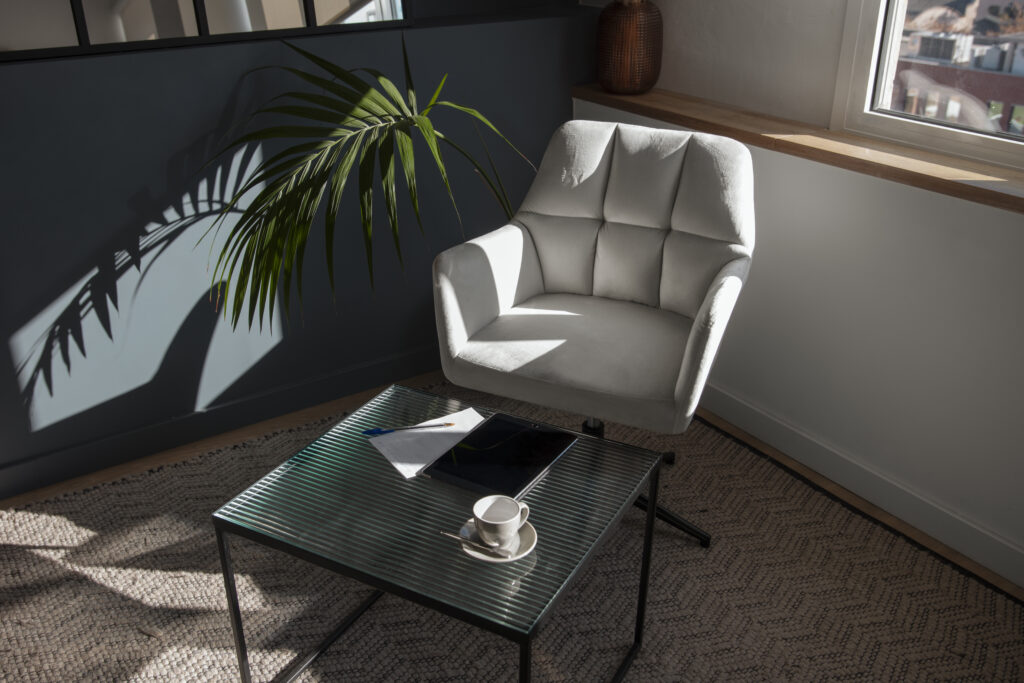
業務用カーペットが重要な理由
- 健康的で生産的な環境を作る: カーペットは巨大なエアフィルターのような役割を果たし、ホコリやアレルゲン、汚染物質を閉じ込めます。定期的に掃除すれば、カーペットは実際に 室内の空気の質を高める-呼吸器系の問題や欠勤の減少に貢献します。あるプロバイダーは、スチームクリーニングが「最大98%のアレルゲンと汚染物質を除去し、より健康的なワークスペースに貢献する」と述べている。
- ノイズを低減し、集中力を高める: オープンプランのオフィス、タイル張りの廊下、病院の病棟などでは、騒音が大きな気晴らしとなります。業務用カーペットは周囲の音を吸収し、反響音を和らげ、より静かで集中できる環境を作り出します。
- 安全性と快適性を高める: カーペットはクッション性があり、足元をサポートするため、滑りや怪我を軽減することができます。また、カーペットの断熱性は熱を逃がさないため、涼しい気候の地域では省エネに貢献します。
- 第一印象を強化する: カーペットが汚れていたりシミがついていたりすると、ブランドのイメージはたちまち損なわれてしまいます。逆に、手入れの行き届いたカーペットは、プロ意識と気遣いを感じさせます。清掃のスペシャリストによると、「清潔で手入れの行き届いたワークスペースは、従業員の士気と生産性を高め」、ビジネスにおける好印象をサポートするという。
- 寿命を延ばし、お金を節約する: 熱水抽出やスチームクリーニングのような専門家による定期的なメンテナンスは、カーペットの繊維とバッキングを保護します。汚れや油分を取り除くことで、カーペットの早期磨耗を防ぎ、カーペットの寿命を延ばし、交換費用を節約します。
- 持続可能性に貢献する: 今日の業務用カーペットは、Green Label Plusをはじめとする環境認証を取得しています。揮発性有機化合物(VOC)が少なく、環境への影響を軽減できるため、LEEDに沿ったプロジェクトや健康志向のプロジェクトでは重要な利点となります。
対象者
- オフィス&コワーキングスペース このような環境では、音響バランスとメンテナンスのしやすさが優先されます。モジュール式タイルカーペットは柄のカスタマイズも可能で、先進的なブランドに最適です。
- ホテル&ホスピタリティ施設 ここでは安全性、保温性、防汚性が優先されます。豊かなデザインは食べこぼしを隠すのに役立ち、丈夫なカーペットは絶え間ない人の往来にも耐えます。
- 医療施設: 病院や診療所では、汚染物質を閉じ込め、騒音を和らげるカーペットの能力が、感染対策と患者の快適性をサポートします。
- 教育機関: 学校には、騒音に対処できる柔らかくて安全な床材が必要です。カーペットは転倒を和らげ、気が散るのを軽減する。
- 商業施設とモール このような場所には、買い物客の動きに耐え、ブランド・アイデンティティを表示し、定期的なディープクリーニングに対応できる耐久性のあるテキスタイルが必要です。
- シニア・リビング&ヘルスケア・センター ここでは、安全性と快適性が最も重要です。カーペットは転倒による怪我のリスクを最小限に抑え、高齢者介護の現場で重要な暖かさを保ちます。
- イベント会場と講堂 人通りの多い通路、鮮やかな美観、騒音防止には、スタイリッシュで丈夫なカーペットが必要です。
5.購入のヒント正しい選択 業務用カーペット
適切な業務用カーペットを選ぶことは、色やスタイルだけの問題ではありません。以下は、カーペットを選ぶ際の重要なポイントです。
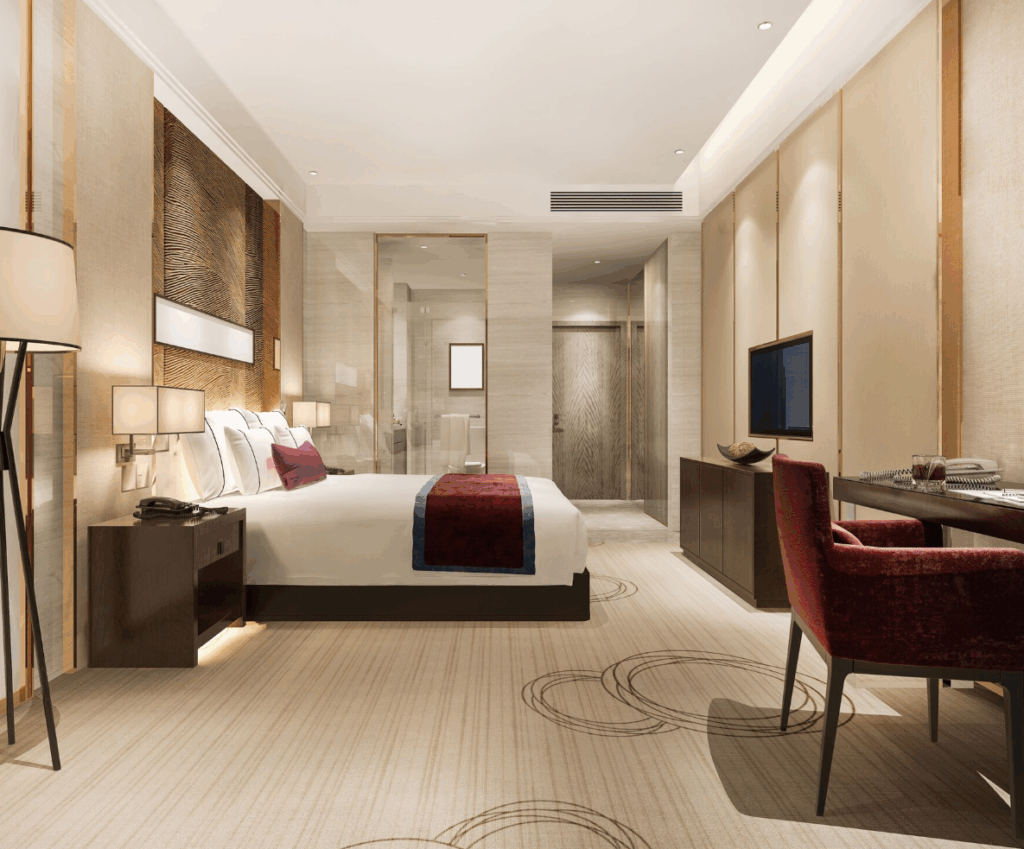
自分のことを明確にする 予算とライフサイクルコスト
初期費用だけでなく、総予算を把握することから始めましょう。業界のガイダンスでは、購入価格、設置、メンテナンス、交換間隔を考慮したライフサイクルコストを重視し、長期にわたる本当の価値を評価するよう指導しています。高品質のカーペットは、初期費用は高くても、耐久性と維持費の削減によって節約できます。
評価 交通と利用ゾーン
通行量の多い場所(エントランス、廊下)、中程度の場所(オフィス)、少ない場所(個人オフィス)。人通りの多い場所には、ベルベルやレベルループのような高密度で低パイルのループカーペットを選びましょう。使用頻度の低い場所には、カットパイルや装飾的なカット&ループパターンが適しています。
理想を選ぶ ファイバー・タイプ
ファイバーの選択はパフォーマンスに大きく影響する:
- ナイロン:耐久性、弾力性、防汚性において業界のゴールド・スタンダード。人通りの多い商業環境に最適。
- ポリプロピレン(オレフィン):耐摩耗性は劣るが、こぼれやすいゾーンや湿気の多いゾーンに適している。
- ポリエステル:鮮やかな色と防汚性を低コストで提供するが、使用量の多い場所では平らになりやすい。
- ウール またはブレンド:高級感があり、燃えにくく、環境にやさしい。
カーペットを選ぶ 構造と形式
- 低パイル・ループ・カーペット:使用頻度の高い環境での高い耐障害性。
- カットパイルとカット&ループ:よりソフトでスタイリッシュ、人通りの少ない場所やエグゼクティブ・スペースに最適。
- タイルとブロードルームの比較:
- タイルカーペット:モジュール式で、パッチの交換が簡単、施工が早い。交通量の多いプロジェクトや段階的プロジェクトにお勧め。
- ブロードルーム:継ぎ目のない外観を提供する。大きな面積を効率的に使用できるが、破損した場合の交換コストは高くなる。
考える バッキング&パッド
高品質のバッキング(ラテックス、熱可塑性プラスチック)は寸法安定性を高め、繊維のほつれを防ぎます。適切なパディングは、快適性と吸音性を高め、カーペットを長持ちさせます。パッドの密度は慎重に選びましょう。ループパイルには薄く固めのものを、プラッシュパイルには柔らかめのものを。
評価 汚れ、汚れ、色あせに強い
溶液染色またはシミ加工カーペットを探しましょう。これらは、コーヒー、インク、食べ物など、職場でよくある食べこぼしに強く、紫外線にさらされても色を保ちます。
獣医 保証と認証
信頼できるメーカーの性能保証(耐摩耗性、防汚性、耐色性)を探す。CRIグリーンラベル・プラスのような認証は、室内空気品質と環境コンプライアンスにとって重要である。
計画 設置の実際
- スケジュール物流:タイルカーペットは、より早く、より少ない混乱で設置でき、シャットダウンできない作業環境に最適です。
- 適切な床下準備:きれいで、水平で、乾燥した(そして湿気テスト済みの)下地は、より良い性能を保証し、早期故障を防ぎます。
- プロフェッショナル・インストレーション:適切な縫い目のアライメント、コーナーの仕上げ、長期的な性能を保証します。
試合 美学とブランディング
パターン、テクスチャー、色を使って、ブランド・アイデンティティをサポートし、磨耗を隠しましょう。多色や柄物のカーペットは、無地よりも汚れや足跡が目立ちません。
テスト サンプル&パイロットエリア
サンプルを入手するか、小さなテストエリアを設置して、外観、使用感、耐久性を評価してから、本格的な使用を開始しましょう。このステップを踏むことで、実際の使用感やメンテナンスのしやすさがわかります。
6.メンテナンス&ケアガイド 業務用カーペット
業務用カーペットは一貫した積極的なお手入れの下で成長します。毎日の正しい習慣、プロのクリーニング、予防策によって、カーペットの寿命を延ばし、美観を保ち、より健康的な職場をサポートします。
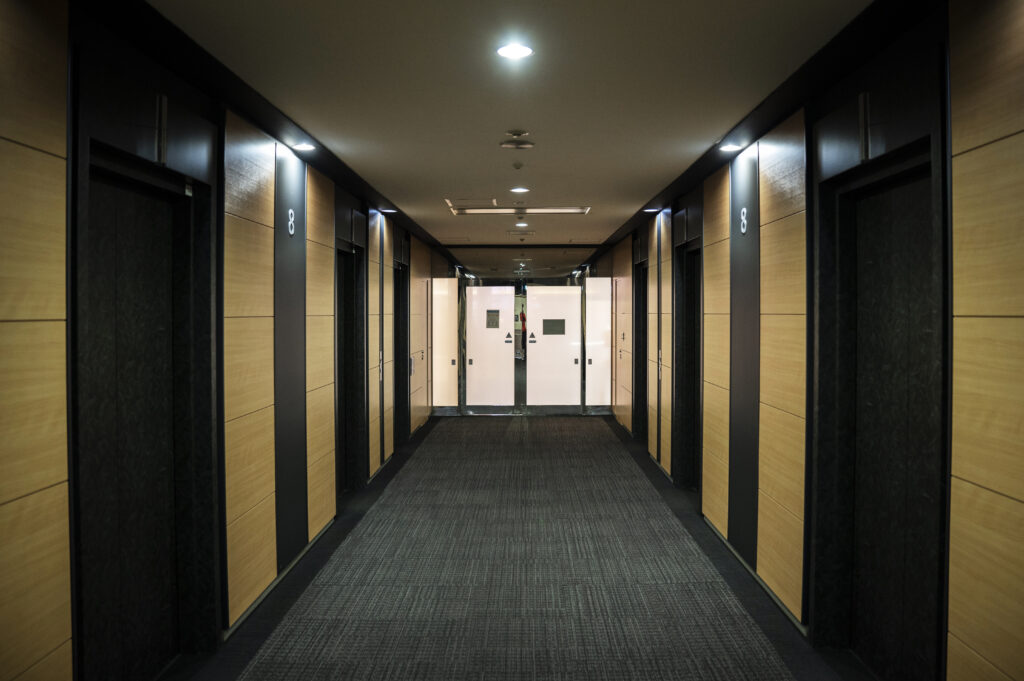
毎日・毎週の予防メンテナンス
- 毎日の掃除機がけ:業務用掃除機(HEPAフィルター付き)とパワーブラシを使用し、表面のほこり、汚れ、粒子を取り除く。ロビー、廊下、カフェテリアなど、人の出入りが多いゾーンは掃除機をかける必要があります。 デイリー または 週に数回 土が繊維に入り込むのを防ぐため。
- 即時の流出対応:こぼれた液は、清潔で吸収性のある布で、こすらずにふき取ってください。メーカー推奨のクリーナーを使用し、必ず最初に隠れた場所でテストしてください。
- 保護マットを使用する:すべての入り口にスクレーパーと吸水マットを置き、汚れや水分がカーペットに到達する前に閉じ込める。
- ノーシューズ・ポリシーまたはシューズカバー・ポリシーを採用する。:屋外のゴミを減らすことで、特にオフィスのラウンジやリラクゼーションゾーンの摩耗を劇的に減らすことができます。
- 居住者の教育:足を拭く、家具を引きずらない、こぼしたものをすぐに片付けるなどの習慣を、掲示や注意喚起で促すことができる。
定期的・専門的クリーニング
| タスク | 頻度 | なぜ重要なのか |
| 熱湯抽出 | 6~12カ月ごと | 最も効果的なディープクリーニング。埋め込まれた汚れ、アレルゲン、残留物を取り除きます。 |
| 低水分洗浄 | 3~6ヵ月ごと | ウェットタイムを最小限に抑え、カビのリスクを減らし、素早く乾燥させるのに理想的。 |
| カプセル化洗浄 | より深い洗浄の間に | 化学的に汚れを結晶化させ、掃除機をかけやすくします。 |
| ボンネット・クリーニング | 必要に応じて | 汚れのひどいものには適さない。 |
*人の出入りが多い場所では、より頻繁なディープクリーニングが必要な場合があります(3~6ヶ月ごと)。
シミ・汚れケアの必需品
- シミをすぐに拭き取る:クリーナーを使用する前に、出来るだけ水分を吸収させることがセッティングを防ぎます。やさしくふき取る。
- カーペット専用でpH中性のクリーナーを選ぶ:残留物を残したり、染料を浮き上がらせたりする刺激の強い化学薬品は避ける。
- 適用前のテスト:変色の可能性を確認するために、目立たない部分で新製品を試してみてください。
- 過湿を避ける:過度の湿気はカビや繊維の損傷につながります。湿った状態でのクリーニングが必要な場合は、十分に乾燥させる(扇風機や除湿機を使用する)。
ディープクリーニングの方法とその利点
- 温水抽出(スチーム洗浄):このゴールド・スタンダードは、ハイパワー掃除機の前に温水と洗剤で汚れを落とす。奥まできれいに、安全に。
- 低水分/ドライコンパウンド:ドライクリーニング用コンパウンドが汚れを吸着し、掃除機で吸い取る。
- カプセル化クリーニング:ポリマーを使用して土壌を結晶化させ、乾燥後に吸引する。残渣が少なく、乾燥が速い。
予防策と長寿の秘訣
- エントリーマットの設置とメンテナンス:マットを定期的に清掃し、交換する。
- 家具のローテーション:交通摩耗のバランスを助け、不均一な圧力スポットを防ぐ。
- 防汚加工を施す:特にディープクリーニングの後は、防汚性を長持ちさせるために保護剤を再塗布してください。
- 縫い目とエッジを定期的に点検する:早期発見が迅速な修理を可能にし、つまずきの危険を防ぐ。
- 専門家による検査のスケジュール:年1回の査定によって、摩耗の問題が深刻化する前に発見することができる。
買い替え時期のサイン
どんなにメンテナンスしても、古くなったカーペットをいつまでも新しく見せることはできません。次のような場合は、買い替えを検討してください:
- 車線が目に見えて平らになったり、色が褪せて見える。
- ディープクリーニングはもはや繊維を蘇らせない。
- 縫い目や裏地に構造上の損傷が見られる。
- 頻繁な修理は、交換費用よりも高くつく。
7.結論
業務用カーペットは、耐久性、スタイル、実用性が求められる環境の味方です。丈夫な繊維、スマートなデザイン、柔軟な施工で作られたカーペットは、雰囲気を高め、維持費を削減します。オフィス、ホテル、店舗のいずれを管理する場合でも、適切な業務用カーペットは投資であり、適切な選択とお手入れを行うことで、美観、快適性、長期的な性能の面で利益をもたらします。
8.よくあるご質問
1. 住宅用カーペットと業務用カーペットの違いは何ですか。
業務用カーペットは耐久性、ローパイル構造、防汚性を優先しています。
2. ブロードルームの代わりにタイルカーペットを使う理由は?
タイルはモジュール化されており、単品での交換が容易で、メンテナンスの費用対効果も高い。ブロードルームは継ぎ目のない美観を提供するが、補修費用は高くなる。
3. 業務用カーペットのディープクリーニングはどのくらいの頻度で行うべきですか?
通常年2回-交通量の多い区域や流出が頻繁な場合はより頻繁に。
4. ポリプロピレン・ナイロン・カーペットは商業用にも使えますか?
ナイロンは弾力性に優れ、ポリプロピレンは汚れに強く予算も抑えられるが、人通りの多い場所では耐久性に劣る。
5 .業務用カーペットの寿命を延ばすには?
定期的な掃除機がけ、素早いシミ抜き、定期的なディープクリーニング、防汚加工の使用は、すべて寿命を延ばすのに役立ちます。

